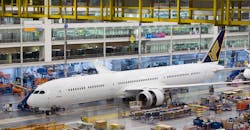Boeing Seen Consolidating 787 Production in S.C.
Boeing Co. is approaching a decision to end production of 787 Dreamliner jets in Everett, Wash., in favor of its plant at North Charleston, S.C., according to sources cited by Reuters, a conclusion that could be announced as soon as October. The possibility emerged in late July when Boeing reported its Q2 2020 results, and announced it will cut 787 production from 10 jets to six per month in 2021.
"With this lower rate profile, we will also need to evaluate the most efficient way to produce the 787," president and CEO Dave Calhoun noted at that time, "including studying the feasibility of consolidating production in one location. We will share more with you following our study."
The report's sources point out that a quick decision is required so that suppliers can adjust their programs for production in 2022. Other sources believe the decision is still undetermined and requires more analysis.
The 787 Dreamliner is a twin-engine, long-range wide-body jet with carrying capacity for 210 to 330 passengers. The 787 aircraft series has been in service since 2011, now with three variants — though the largest of these, the 787-10 is assembled exclusively at North Charleston.
While the 787 has been highly successful and profitable for Boeing, it is currently the subject of inquiries and maintenance directives concerning manufacturing errors. This adds to Boeing's entirely separate problem with the 737 MAX series, as well as the ongoing collapse in aircraft demand — the latter of which has prompted the concern about the 787 program's overall requirements and costs.
The OEM's strategy of supporting two plants to create capacity and production cost flexibility is under reevaluation now that the Covid-19 pandemic has altered commercial aerospace activity and growth forecasts.
The Washington State manufacturing complex has been Boeing's center of activity for many decades, though it relocated its headquarters to Chicago in 2001.
The second manufacturing base was intended to create flexibility, in particular for labor costs. Boeing has had various conflicts with unionized employees in Everett, and South Carolina is a "right to work" state. A series of efforts by the International Assn. of Machinists over the past nine years have failed to organize workers Boeing workers in South Carolina.
An IAM chapter president in Washington State is cited by Reuters as arguing that Boeing could be planning the move in order to win contract concessions as its manufacturing forecast grows less optimistic.
